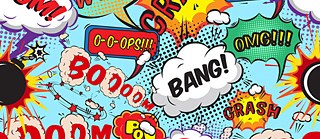Comics
E-Comics

The digital revolution in the publishing industry has now hit comic books, too. E-comics are a special challenge because the text and pictures have to be put online creatively and interactively. Most publishers in Germany, however, are sceptical about this digital development.
Not so Samuel Petit, who is working with French publishers to develop new e-comic formats for the web: “We’re in the exciting phase of developing new code for digital and graphic reading. This is a different form of comic art,” he announces. And yet despite the open enthusiasm, publishers are not quite as forthcoming about sales of digital comics, whether in Germany or elsewhere. In fact there are no statistics to be had in Europe. The development of the Europeane-book market is more of an evolution than a revolution: in 2012, for example, e-books accounted for 2.4 per cent of book sales in the private consumer market in Germany, but the share of e-comics sales wasn’t even calculated. Even in the US – the biggest market, together with Japan, in the comics sector – digital comics only accounted for 1 to 1.4 per cent of sales in 2012.
E-comics scene in Germany
And yet the smaller the niche, the greater the ambition and artistic freedom – which goes for e-comics too. Experiments in digital comics have been under way for 15 years now, starting in America, followed by France; the trend first hit Germany in 2005. It wasn’t the publishers, but the authors themselves who experimented with their auto-fictional comics blogs, such as Berlin illustrator Flix with his Held (Hero). “The comic diaries were interesting”, recalls Josefin Svenske at Kolik, a Swedish comics publisher, “because personal topics were illustrated in a poetic way there, and readers could comment and exchange views.” Authors soon embarked on a new online adventure that involved breaking with the page-by-page format of the conventional comic book, so readers can now scroll through a story vertically or horizontally without stopping, without having to pause and turn the page, which makes for an effect of full immersion in the story.And yet big German publishers like Carlsen and Egmont shied away from the digital market for a long time. Market leader Panini broke the first ground in 2012, initially trying to market e-comics on their own platform paninidigits.de. But without success, so they had to close up their online shop. In April 2014, however, the Stuttgart publisher launched a fresh “e-comics offensive”. Since then, some 150 comics titles can now be downloaded from the site, with six to eight new titles to be added each month in the second half of 2014. And that’s no “April fool’s hoax”, say Panini, who have clearly grown somewhat more cautious since their first abortive e-book experience.
France fires up the turbo
E-comics have now taken off into the third dimension, however, with the help of animation. And they’re taking touchscreens by storm in this digital age, which calls for a technology that can tell stories in the smallest spaces, too, to make reading on a smartphone or tablet screenfun. The French are pioneering this new technology. In search of an e-comics aesthetic of their own, the French are developing a “mode turbomedia”, in which the comic book publishers and illustrators in Japan and America are also showing an interest lately. Thanks to this technology, readers don’t have to click their way from one picture to the next: the story evolves interactively, inside a single drawing. Imagine a single panel, for example, depicting a stormy sky. You click on the screen and animated raindrops appear. Click again and a speech balloon pops up, followed by a human figure. What would take three panels to portray on paper materializes here progressively in a single picture. The reader sets the pace of the story’s progression by clicking their way along and so retains control over their own reading experience.Several examples can be found on Professor Zyklop, a Franco-German web platform started up by the Franco-German TV network Arte. The man in charge of the German version is Michael Grönewald from Reprodukt-Verlag, an independent comic book publisher in Berlin.